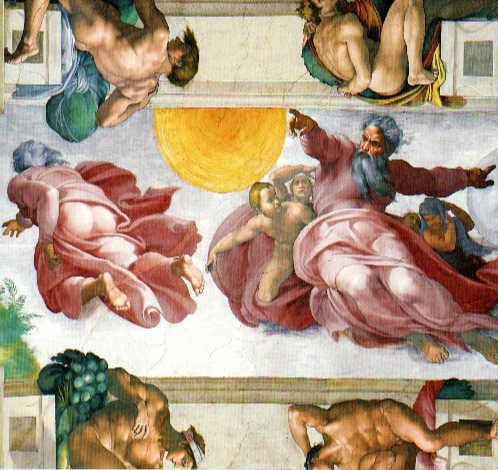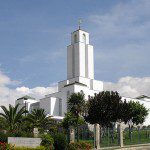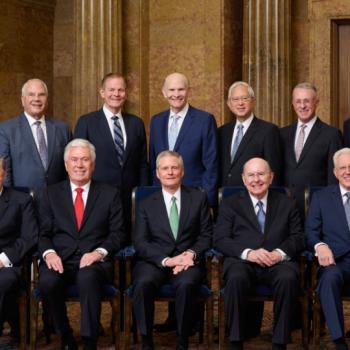
Michelangelo Buonaroti (Wikimedia CC public domain image)
I hope that you caught Richard L. Bushman’s magnificent opening keynote speech for the Book of Moses conference last night. It was remarkable. And the presentations so far this morning — by Kent P. Jackson and Kerry Muhlestein and David Rolph Seely and Stanford Carmack — have also been very, very good:
Tracing Ancient Threads in the Book of Moses
***
Matthew L. Bowen, “Alma — Young Man, Hidden Prophet”
Abstract: The biographical introduction of Alma the Elder into the Book of Mormon narrative (Mosiah 17:2) also introduces the name Alma into the text for the first time, this in close juxtaposition with a description of Alma as a “young man.” The best explanation for the name Alma is that it derives from the Semitic term ǵlm (Hebrew ʿelem), “young man,” “youth,” “lad.” This suggests the strong probability of an intentional wordplay on the name Alma in the Book of Mormon’s underlying text: Alma became “[God’s] young man” or “servant.” Additional lexical connections between Mosiah 17:2 and Mosiah 14:1 (quoting Isaiah 53:1) suggest that Abinadi identified Alma as the one “to whom” or “upon whom” (ʿal-mî) the Lord was “reveal[ing]” his arm as Abinadi’s prophetic successor. Alma began his prophetic succession when he “believed” Abinadi’s report and pled with King Noah for Abinadi’s life. Forced to flee, Alma began his prophetic ministry “hidden” and “concealed” while writing the words of Abinadi and teaching them “privately.” The narrative’s dramatic emphasis on this aspect of Alma’s life suggests an additional thread of wordplay that exploits the homonymy between Alma and the Hebrew root *ʿlm, forms of which mean “to hide,” “conceal,” “be hidden,” “be concealed.” The richness of the wordplay and allusion revolving around Alma’s name in Mosiah 17–18 accentuates his importance as a prophetic figure and founder of the later Nephite church. Moreover, it suggests that Alma’s name was appropriate given the details of his life and that he lived up to the positive connotations latent in his name.
Abstract: Jonathan Neville, an advocate of the “Heartland” geography setting for the Book of Mormon, claims to have identified a novel chiastic structure that begins in Alma 22:27. Neville argues that this chiasmus allows the reconstruction of a geography that stretches south to the Gulf of Mexico in the continental United States. One expert, Donald W. Parry, doubts the existence of a fine-tuned chiasmus in this verse. An analysis which assumes the presence of the chiasmus demonstrates that multiple internal difficulties result from such a reading. Neville’s reading requires two different “sea west” bodies of water: one “sea west” placed at the extreme north of the map and a second sea to the west of Lamanite lands, but neither is to the west of the Nephites’ land of Zarahemla. Neville’s own ideas also fail to meet the standards he demands of those who differ with him. These problems, when combined with other Book of Mormon textual evidence, make the geography based upon Neville’s reading of the putative chiasmus unviable.
John Gee, “Shulem, One of the King’s Principal Waiters”
Abstract: Shulem is mentioned once in the Book of Abraham. All we are told about him is his name and title. Using onomastics, the study of names, and the study of titles, we can find out more about Shulem than would at first appear. The form of Shulem’s name is attested only at two times: the time period of Abraham and the time period of the Joseph Smith papyri. (Shulem thus constitutes a Book of Abraham bullseye.) If Joseph Smith had gotten the name from his environment, the name would have been Shillem.
Craig L. Foster, “Conversations with Mormon Historians”
Review of Alexander L. Baugh and Reid L. Neilson, eds., Conversations with Mormon Historians, Religious Studies Center, Brigham Young University, Provo, Utah, in cooperation with Deseret Book Company, Salt Lake City, 2015. pp.580 + xv, including index. $34.99.
Abstract: Conversations with Mormon Historians is a compilation of interviews with sixteen Latter-day Saint scholars. The book reveals why they went into their chosen professions, their rise to prominence as historians, and their thoughts regarding important topics such as the Prophet Joseph Smith and the restoration of the gospel of Jesus Christ.
***
And now, on a very different but urgently important topic:
“Herd Immunity and COVID-19: 5 Things to Know”
“Only 2 ‘breakthrough’ infections among hundreds of fully vaccinated people, new study finds”
“Tabernacle Choir at Temple Square cancels Pioneer Day concert”
“Vaccination Is Our Ticket Out of the Pandemic”
“As bodies pile up, India’s leaders face rising public anger over second Covid-19 wave”
“CDC recommends that pregnant people get a Covid-19 vaccine”
“CDC, FDA lift pause on using J&J’s coronavirus vaccine, add safety warning”
“Familiar splits among white ‘evangelicals,’ only now they’re about vaccines”
“Church recommends all missionaries ‘safeguard themselves’ with COVID-19 vaccination”
Please consider the links that I give here part of my attempt to have a “tough talk” for those who are resisting vaccination. Am I alone in fearing that, if we don’t get the spread of the coronavirus under control, we may have another pandemic-ruined year ahead of us? I desperately want the temples to reopen and missionaries to be back out among the people — to say nothing of theaters and restaurants to go back to normal. The goal is within reach. But it’s also entirely within our capacity to keep this thing going. On and on and on and on.
Please. Get your vaccination. Wear a mask. Wash your hands. Maintain social distance just a bit longer. Let’s put an end to COVID-19.











